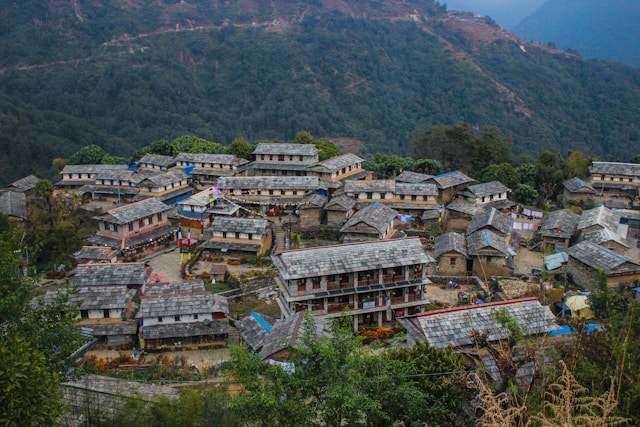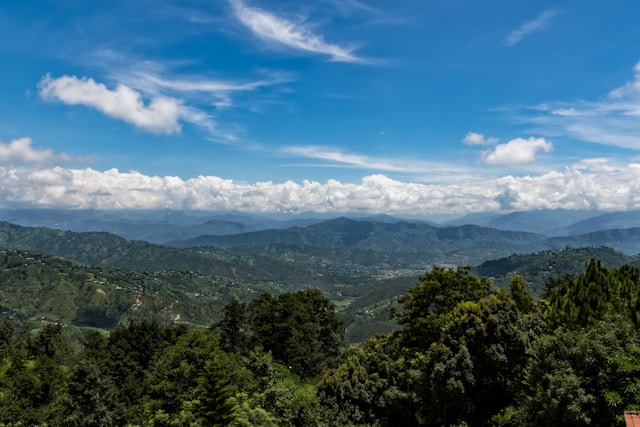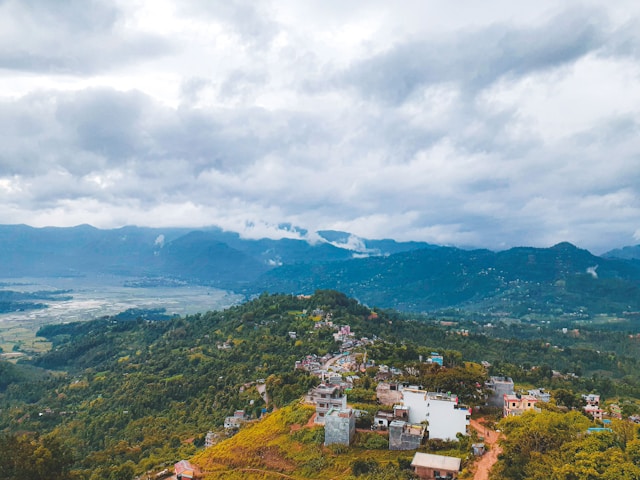Nestled in the lap of the Annapurna mountain range, Ghandruk is not merely a village—it is a living museum of Gurung heritage, where traditional values blend seamlessly with breathtaking natural surroundings. At an altitude of 2,012 meters above sea level, Ghandruk serves as both a serene Himalayan getaway and a cultural time capsule. From the rhythmic beat of daily rural life to the unmatched vistas of snowcapped peaks, village life in Ghandruk stands as a timeless tribute to harmony between humans and nature.
A Gateway to the Annapurna Region
Ghandruk is strategically located on the popular Annapurna Base Camp trekking route, making it a favored stop for both seasoned trekkers and curious travelers. The trail leading to Ghandruk winds through lush forests of rhododendron, cascading waterfalls, and stone-paved paths flanked by terraced fields.
As travelers approach, they’re greeted by the magnificent peaks of Annapurna South, Hiunchuli, and Machapuchare (Fishtail)—all appearing close enough to touch. The proximity to these iconic peaks elevates the entire village experience, making Ghandruk one of the most scenic highland settlements in Nepal.
Traditional Gurung Architecture and Village Layout
The architecture of Ghandruk is a visual symphony of form and function. Homes are built with stone slabs and topped with slate roofs, designed to endure harsh mountain weather. Narrow, winding lanes and stairways interconnect the entire village, creating a communal layout that encourages interaction and unity among its residents.
Each house usually features intricately carved wooden windows and door frames—a testament to the artisan skills passed down through generations. Courtyards are central to household life, where vegetables are sun-dried, herbs are hung, and generations sit together to exchange stories. These homes are not merely shelters—they are custodians of generational knowledge, ancestral customs, and communal values.
Gurung Culture and Living Traditions
The soul of Ghandruk lies in its Gurung community, whose customs and traditions have been lovingly preserved. The villagers speak their own language, wear distinct traditional attire, and celebrate numerous local festivals with dance, song, and ritual.
The Aama Samuha (Mother’s Group) plays a significant role in preserving and promoting Gurung culture. These women organize folk dance performances such as Ghantu and Sorathi, especially for visitors, offering a unique cultural immersion. The Gurung Museum in the village further enhances this cultural journey, housing ancient tools, traditional clothing, and photographs that narrate the village’s ethnographic evolution.

Agriculture and Daily Rhythms of Rural Life
Agriculture remains the backbone of Ghandruk’s economy and way of life. Villagers cultivate rice, maize, millet, and potatoes on steep terraced fields carved into the hillsides. In addition to farming, animal husbandry—including the rearing of buffaloes, goats, and chickens—plays a crucial role in sustaining the local economy.
Daily life begins with the first rays of sunlight spilling over the mountains. Men tend to livestock or work in the fields, while women manage household tasks, weave wool, and prepare meals over open hearths. Children, when not in school, assist with chores, embodying a strong work ethic from an early age. Time in Ghandruk is marked not by clocks but by the sun and seasons, aligning villagers intimately with nature’s rhythms.
Eco-Friendly and Sustainable Living
One of the defining traits of life in Ghandruk is its environmentally sustainable practices. The villagers have long lived in accordance with nature, adopting eco-friendly habits that urban areas now seek to emulate. Firewood is used sparingly, solar panels power many homes, and waste is either composted or reused.
The village is also a forerunner in promoting eco-tourism, with several eco-lodges offering organic food, waste segregation, and water conservation practices. Locals are keen on educating both residents and travelers about the importance of maintaining the fragile Himalayan ecosystem. Sustainability is not a concept here—it is a tradition.
Education and Community Development
Ghandruk has made considerable progress in the fields of education and community welfare. The presence of local schools and women-led cooperative groups reflect the village’s commitment to empowering its people. Organizations like ACAP (Annapurna Conservation Area Project) have partnered with local stakeholders to improve infrastructure, health facilities, and sustainable tourism initiatives.
Young people often leave for higher education or job opportunities in Pokhara or Kathmandu but maintain strong ties with their hometown, often returning to support family and community events.
Homestays and Authentic Rural Experiences
What truly distinguishes Ghandruk from other villages is its warm embrace of visitors through authentic homestay experiences. Staying in a local household gives travelers a unique opportunity to partake in the village’s daily life—be it helping with farming, cooking traditional meals, or joining in folk songs around a fire under a star-studded sky.
Guests are welcomed with a hearty “Namaste” and served home-cooked meals like dhido, gundruk ko achar, and yak cheese, often prepared from ingredients grown in the backyard. Such immersive experiences create lasting cross-cultural bonds, far beyond the superficial tourist gaze.
Sacred Sites and Spiritual Significance
Ghandruk is home to several sacred temples and monasteries, reflecting the spiritual depth of its inhabitants. The Baraha Temple, perched on a hilltop, offers not only spiritual solace but panoramic views of the valley below. Prayer flags flutter in the breeze, and the scent of incense hangs in the air, providing a sensory reminder of the village’s spiritual heartbeat.
Rituals tied to the lunar calendar and ancestral spirits are still performed, maintaining a connection to the metaphysical world that complements the village’s physical beauty.
Ghandruk Through the Seasons
Each season paints a different picture of Ghandruk. In spring, rhododendrons bloom in vibrant hues, while summerbrings lush greenery and cascading waterfalls. Autumn, the peak trekking season, showcases clear skies and golden harvests. Winter turns the village into a snowy wonderland, quieter but equally enchanting.
No matter the season, Ghandruk exudes an enduring charm—offering travelers an enriching experience that is both sensory and soulful.
Conclusion: Where Time Stands Still
In Ghandruk, tradition meets tranquility, and life flows gently against the backdrop of towering peaks and endless skies. The harmony between heritage and nature is not just a poetic ideal here—it is a lived reality. For those yearning for a deeper connection to the land, culture, and people, Ghandruk offers a timeless retreat where the essence of Nepalese village life continues to thrive undisturbed.


